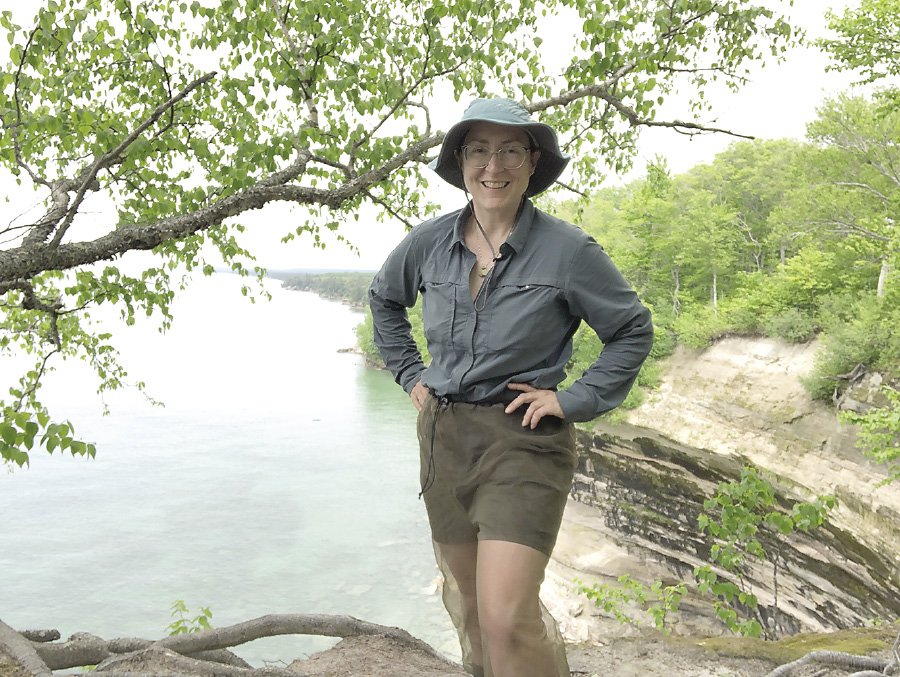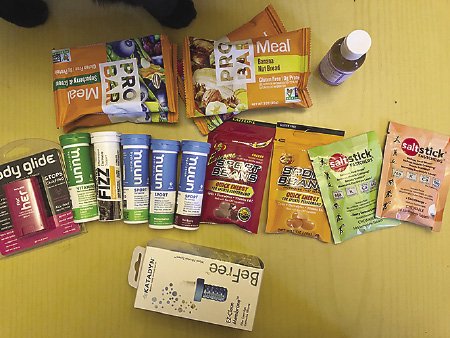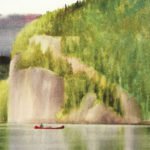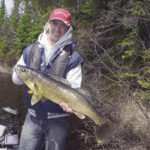While backpacking on the Border Route Trail north of Grand Marais, a black fly flew straight down my ear canal.
I froze; the fly buzzed madly inside my ear. I promptly went crazy with the need to get this fly out of my ear. Yelling, jumping around, I poured water into my ear until the fly drowned, which caused an ear infection a couple days later.
During the past three years, I’ve hiked more than 2,000 miles on north woods trails. I’ve learned a lot of lessons the hard way. Welcome to the Hiking School of Hard Knocks.
Bugging Out
After my bug-induced temporary insanity, I learned some tricks for managing the ticks, mosquitoes and black flies, because I love hiking during bug season. How else am I going to eat my body weight in fresh thimbleberries?
Instead of pesticides, I prefer to use what I call “bug armor,” a layered clothing approach. I hike in baggy, quick-drying pants, which prevent bugs from making contact with my skin. The same goes for my shirt: long-sleeved, quick-drying, baggy. I tuck my pants into my socks, and my shirt into my pants. I use a head net, but also a full suit of bug netting made by Coghlan’s. If the bugs are still too bad, I wear my rain gear, which nothing can bite through.
For ticks, I check myself every time I stop for a break, and again at the end of the day.
Beware of the Animal Trail
As a novice day hiker, I thought only humans made trails. Animals just wander wherever they want through the trees and underbrush, right? Hiking in Rock Bridge State Park in Columbia, Mo. near dusk, I saw a narrow trail cutting off the main path.

Eager to explore, I followed it as it wound its way past a series of sinkholes. Suddenly, the trail disappeared. No big deal, I thought, I’ll just turn back. When I turned around, the trail had disappeared from behind me as well.
Like a thunderclap, I realized I’d been following an animal trail. I was miles from the trailhead, and had only a vague idea of its direction. The sun was setting and I guessed I had about an hour of sunlight. I had half a 20 oz. bottle of water and half a Snicker’s bar in my purse. I didn’t have a map, compass, or headlamp. I didn’t own a cell phone. “I might have to spend the night out here,” I thought.
Panicking, I did the exact thing you’re not supposed to do. I charged off into the woods in a direction I hoped was heading back to the main path. I never found my animal trail again, but after half an hour of bushwhacking, I found a human trail.
With 20 more years of hiking experience, I know animals create trails that can look identical to human-built trails. Beavers create paths while dragging trees that can look professionally built by trail crews.
I made several mistakes on that hike. I didn’t let anyone know where I was and when to expect me back. I didn’t have any way to call for help. I had no navigation tools. Now I always carry a basic survival kit, even on day hikes: Two water bottles, a water filter, enough food for a full day, an emergency blanket, my rain gear, a warm layer, a compass, maps, a cell phone with a GPS app, a knife, a head lamp, a small first-aid kit, a back-up battery for my phone, and fire-starting materials. I also make sure someone knows where I am and when I’ll be back.
Double-check Your Gear
During a pouring rainstorm in August 2017 on the Superior Hiking Trail, I stood shivering violently beneath a pine tree. In the low 50s with winds gusting 10-15 miles per hour, I’d been hiking in the rain for hours, and was starting to wonder if I was in danger of developing hypothermia.
My five-year-old rain coat was no longer waterproof. I hadn’t thought to check it before leaving on a three-month trek. In camp that night, I found huge cracks in the seam sealing. When I went to a gear shop to replace it, a clerk told me most raincoats lose their waterproofing after a few years. I had no idea.
Heat and Humidity Almost Killed Me, Twice
The two times I’ve come closest to calling for emergency help while in the backcountry were both due to mismanaging the heat and humidity.
On the Border Route Trail in July 2017, the humidity hovered around 90 percent. Sweat was pouring off of me. I was chugging water. I was about to learn, in the scariest way possible, that overhydrating can be as dangerous as dehydration.
Setting out from a campsite at Pine Lake, I climbed up a short ridge on legs that felt like Jell-o. My vision went blurry, fuzzing black at the edges. I lay down on the trail, thoroughly confused as to what was going on. After resting for a full hour and only feeling worse, like I was going to pass out, my hiking partner and I backtracked to camp and took an unplanned rest day. If we hadn’t taken a wilderness first aid course as a safety precaution before my hike, we never would’ve known I was probably developing a case of hyponatremia, when the level of salt in your body gets so low, your cells don’t function normally. Serious cases can result in coma and death.

I’d been drinking tons of water, but eating barely any salt or electrolytes. I disliked salty foods and hadn’t packed any. Even my trail mix was salt-free. As soon as we figured out what was going on, I stopped drinking water, and started sipping small amounts of salted Gatorade. I ate my hiking partner’s salty trail mix. I lay in my tent feeling so terrible, I came close to pushing the SOS button on my InReach several times. After a day of rest, I was still weak, but able to continue hiking.
In July 2019, I was halfway through the Trap Hills in a very remote part of Upper Peninsula Michigan. It was so hot and humid, I felt like my brain was melting. The Trap Hills are gorgeous, similar to the Sawtooth Mountains, and full of hard climbs. Over a period of days, I overexerted myself while being unable to escape the heat. Eventually, I got so weak, I fell and injured myself pretty badly. I decided to retreat to town.
Afterward, other hikers told me I’d probably come close to suffering heat exhaustion, which can escalate quickly to heat stroke and kill you. I’d learned another scary lesson: find ways to cool yourself down if you start feeling sick in the heat. Don’t just drink water, get in a lake or creek. Avoid hiking during the hottest part of the day. Take your shirt off, soak it in the creek, and put it back on.
Hopefully, learning from my hard knocks will help your lessons in the woods feel more like soft taps. Happy hiking!




